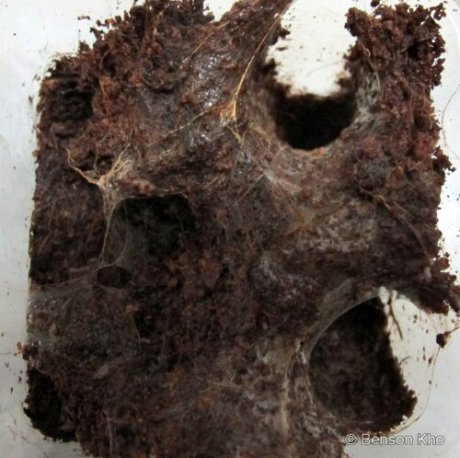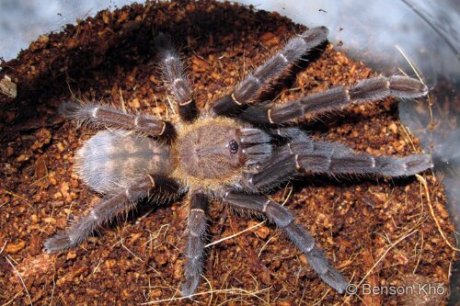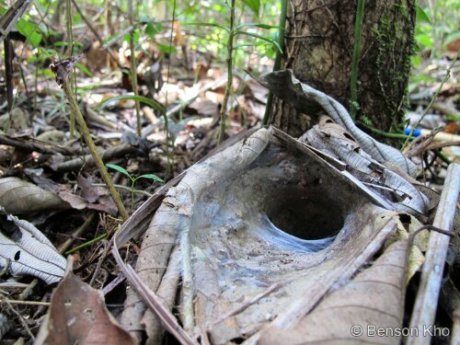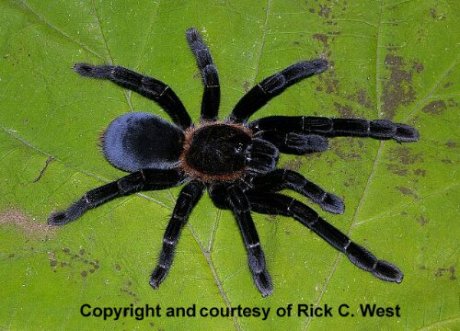The Earth Tigers of Borneo
– my encounter with the Borneo Orange Fringe Tarantula
Location: Sarawak – somewhere in the rainforest
Dusk approach and the sky slowly turns dark. Soon, below the canopy the Bornean rainforest is now pitch black covered in total darkness. I turn my flash light on and proceed with caution while my eyes scan the forest floor and tree holes. I’m looking for possible burrows lined with silk. It is 8pm with the call of crickets getting louder and bugs searching for mate and food, while geckos and other predators prey on them. All of them seem busy, except this one…. I’ve found it! A juvenile Haplopelma Doriae (Thorell, 1890)
Patiently it lies await (rock still) in the entrance of its burrow, waiting for the perfect moment to pounce on unsuspecting prey – this is how a tarantula hunt, there is no escape once it touches its prey, only a quick death.
Belonging to the subfamily Ornithoctoninae the genus Haplopelma is one of many old-world tarantulas found in Southeast Asia ranging from Cambodia, southeastern China, Myanmar, Vietnam, Thailand, Malaysia, Singapore, and Borneo.
A huge burrowing species capable of reaching an adult size of 8 inches in leg span, this is one of Borneo’s earth tiger tarantulas, a jewel to any serious collectors. Like other asian tarantulas, this species is lightning fast and possess stronger venom.
Following a study of the holotype of Haplopelma Doriae, the Borneo Orange Fringe Tarantula (Ornithoctoninae sp. orange fringed) is, in the opinion of German arachnologist Volker von Wirth a Haplopelma Doriae (unpublished).
The Borneo Orange Fringe tarantula is divided into variants; one with prominent orange fringe of setae around its carapace and one without. According to Søren Rafn, the former is Haplopelma Doriae from Northern and Eastern Borneo, whereas the latter is termed sp. Kalimantan from the South-Western part of Borneo. However there is yet to be any scientific evidence, neither is there published paper on weather these two are actually the same species, or altogether a different species (correct me if I’m wrong).
In the wild, they are found deep within the jungles of Borneo. The specimen I came across built its burrow in a rotten tree trunk with moss growing nearby. From my personal observations, slings and young juveniles are sometimes found in tree holes up to a meter high up. However, all adults that I’ve came across are found in burrows on the ground by tree trunks. These burrows are deep and tunnel under tree roots which I believe helps protect its burrow. Other features includes multiple exits in a burrow enabling the tarantula to easily escape should the need arise. This feature has been observed both in the wild and from my personal collections.

The above belongs to one of my juvenile Haplopelma Doriae (below). Its burrow consist of a main chamber. It connects to multiple tunnels leading up to the surface.


Typical burrow of an adult Haplopelma Doriae in the wild (above). Notice beautifully arranged leaves on the entrance to its burrow. Some experts believe the leaves help direct water to prevent it from flowing into its burrow, hence avoiding from being flooded during heavy rainfall.
Although this unique species live deep within Borneo, I managed to find quite a number of active burrows within close proximity to Kuching city. Their locations are recorded for educational and observational purposes only. Unfortunately, these habitats are under threats from urban and suburban developments such as the building of roads and housing.
Hence, it is only a matter of time that these unique creatures face an inevitable decline in population. Their only hope lies in nature reserves such as national parks and most importantly, our knowledge about them. Perhaps tarantula hobbyist/enthusiast can play their role in contributing to this knowledge and conservation via captive breeding. So the next time if you come across a huge spider while camping or jungle tracking, you might have just stumble upon a Borneo Earth Tiger.


